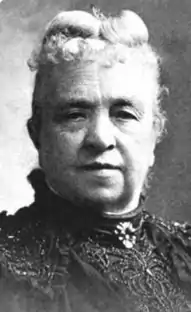Ellen Cheney Johnson
Ellen Cheney Johnson (December 20, 1829 – June 28, 1899) was an American prison reformer. She founded the New England Women's Auxiliary Association to the United States Sanitary Commission, worked with homeless and vagrant women after the Civil War through the Dedham Asylum for Discharged Female Prisoners, and served as superintendent of the Massachusetts Reformatory Prison for Women at Framingham.[1]
Ellen Cheney Johnson | |
|---|---|
 Ellen Cheney Johnson, from a 1900 publication | |
| Born | Ellen Cheney December 20, 1829 Athol, Massachusetts |
| Died | June 28, 1899 (aged 69) London, England |
| Signature | |
Early life
Ellen Cheney was born on December 20, 1829 in Athol, Massachusetts.[2][3] She was the daughter of Nathan Cheney (a mill agent) and Hoda Holbrook. Ellen attended the Academy at Francestown, New Hampshire. She later became a teacher at Weare, New Hampshire, where she was also an alumna.
When she was eighteen she joined a temperance organization. Two years later, she met and married Jesse Cram Johnson from Unity, New Hampshire, and moved to Boston.[2]
Early influences
Her home near the State House in Boston became a meeting place for welfare workers. Johnson founded the New England Women's Auxiliary Association which in turn led her to an important position in the U.S. Sanitary Commission.[3] She was involved with the executive and finance committees of the New England branch of the commission.
During this time she would visit numerous correctional facilities and helped poor women around Boston so they could better fend for themselves. Throughout all this, Johnson witnessed the abuse which female prisoners had to endure.[4] At this time, female prisoners were not separated from their male counterparts. Neither were the children they brought in with them, or the ones that were born in jail.
Johnson began a crusade for the reform of female treatment in correctional facilities. She and other women gathered at her home and began writing letters to newspapers requesting a separate facility for females. Their letters brought the subject to legislature. They gathered over 7,000 signatures which helped pass the bill for an all-female prison in 1874.[3]
In the meantime, she became the leading advocate for the Temporary Asylum of Discharged Female Prisoners in Dedham, MA. The Reformatory Prison for women was finally opened in 1877 in Sherborn, near Framingham, MA. Johnson, being one of the five commissioners for the prison, became the superintendent of the prison.
Career
Ellen Cheney Johnson, while running the Massachusetts Reformatory Prison for Women at the turn of the nineteenth century, tried to bridge the approaches of rehabilitation and punishment. As she put it in her own writings, "No lesson is more important than that which teaches respect for the law and dread of its wrath. At the same time, it is a fundamental point in our theory that every criminal can be won by gentleness and patience."[5]
Jonson created programs inside the prison and outside as well to help the women achieve their goals. She developed a system of indenture for house service in houses outside the prison walls. This was all done under sympathetic supervision.
End of an era
Johnson ran the prison for fifteen years and was awarded a bronze medal and diploma for her achievements in the prison system by the World's Columbian Exposition:
for evidence of a model management in every detail.
Her reformatory system has been studied thoroughly and received the highest praise from prison experts.
She died suddenly while in London, England after addressing the International Congress of Women on June 28, 1899.[6] Ellen Johnson left money to the city of Boston to build the Johnson Memorial Fountain (later renamed Westland Gate) in memory of her husband, Jesse Johnson.[7][8]
References
- Freedman, Estelle (1974). "Their Sisters' Keepers: An Historical Perspective on Female Correctional Institutions in the United States: 1870–1900". Feminist Studies. 2 (1): 77–91. doi:10.2307/3177698. JSTOR 3177698.
- Malone, Dumas, ed. (1933). Dictionary of American Biography. Vol. 10. New York: Charles Scribner's Sons. pp. 98–99. Retrieved April 29, 2022 – via Internet Archive.
- "Notable women of Worcester County". www.wwhp.org.
- Joann Morton, "The 'agency of women'--Women and ACA", Corrections Today 57. 5 (August 1995): 74.
- Cristina Rathbone, A World Apart: Women, Prison, and Life Behind Bars (New York: Random House, 2005), 132.
- "Life Work Ends: Noble Woman Passes to Her Reward". The Boston Globe. June 28, 1899. p. 4. Retrieved April 29, 2022 – via Newspapers.com.
- "Johnson Memorial Fountain and Gate, (sculpture)". Save Outdoor Sculpture, Massachusetts survey. 1997. Retrieved December 6, 2011.
- "Gift to the City of Boston". The Boston Globe. July 18, 1899. p. 8. Retrieved April 29, 2022 – via Newspapers.com.
Further reading
- Banks, Cyndi (2003). Women in Prison: A Reference Handbook. Santa Barbara, Calif.: ABC-CLIO. pp. 150–151. ISBN 9781576079294.
- Barrows, Isabel C. (October 13, 1900). "Ellen Johnson and the Sherborn Prison". The Friend: A Religious and Literary Journal: 100.
- Leonard, Clara T. (July–December 1878). "Prison for Women". Sunday Afternoon. Springfield, Mass. 2: 105–111.
- James, Edward T., ed. (1971). Notable American women, 1607–1950: A Biographical Dictionary (2nd ed.). Cambridge, Mass.: Belknap Press of Harvard University Press. ISBN 0674627318.